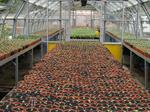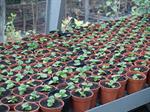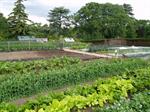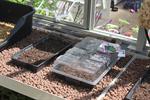
Lesson Structure
There are 9 lessons in this course:
- Introduction
- scope
- open ground propagation
- controlled environment propagation
- Seed Botany
- anatomy
- physiology
- pollination
- hybridisation
- genetic purity, etc.
- Seed Sources
- selection
- collection
- timing
- wild collecting
- Seed Storage
- treatments
- cleaning
- drying
- storage
- disease control
- germination testing
- Dormancy
- Germinating
- annuals
- perennials
- vegetables
- Propagating selected Woody Species

- Direct Seeding
- grasses
- woody species
- revegetation projects, etc.
- Seedling Management
Each lesson culminates in an assignment which is submitted to the school, marked by the school's tutors and returned to you with any relevant suggestions, comments, and if necessary, extra reading.
Aims
- Discuss the nature and scope of commercial seed propagation.
- Explain the botanical characteristics of seed and the processes that occur when a seed germinates.
- Determine appropriate procedures for harvesting different seeds in different situations.
- Determine appropriate treatments for different types of seeds following harvest in order to sustain viability.
- Determine appropriate treatments for breaking dormancy in order to initiate germination with a range of different seeds.
- Determine how to sow and germinate seed of commonly grown herbaceous plants including vegetables, annuals and perennials.
- Determine appropriate propagation techniques for a range of woody plants including trees, shrubs, ground covers and climbers.
- Determine propagation and plant establishment strategies for developing a variety of different types of plantings through direct seeding onto sites where germinated plants will remain permanently in the position where the seed germinates.
- Manage germinated seedlings as they develop in a way that will optimise the survival rate.
How to Propagate a Plant from Seed
 The two main methods of seedling propagation are:
The two main methods of seedling propagation are:
- Direct sowing – seeds are sown (by hand or machine) into individual pots, planting trays or planting cells (trays with many individual cells that are usually tapered slightly to aid and improve root formation).
- Broadcast sowing - the seed is onto the trays randomly then ‘pricked out’ as seedlings into individual pots, cells or planting trays when they are large enough to handle.
The direct sowing method is the best approach (if possible), as it produces stronger seedlings and a much stronger natural root system. The advantage of direct sowing is that the natural root system:
- increases good anchorage
- reduces wind-throw
- has a more efficient up-take system for nutrients and water - which increases growth rates
The broadcast method requires the ‘pricking out’ of seedlings. This method can create problems such as constricted or coiled root systems that can result in J-rooting (curled roots in the planting hole) causing instability (wind-throw), and stress caused by transplanting, resulting in poor or uneven growth.
- Commercial trees for forestry, fruit trees, ornamental trees etc are best planted by the direct sowing method.
- Vegetables and colourful annuals and perennials are often sown using the broadcast method and later pricked out into individual pots or communal containers (punnets) of up to 12 per container.
- Seedlings produced in the open ground are later often sold ‘bare-rooted’, this includes species such as fruit tree root stock, rose root stock and other root stock used for ornamental trees etc. The seeds are usually sown into a seed-lot in quite large numbers.
- Seedlings of pine trees are also produced in the open-ground and are later sold with a small amount of soil on the roots (but virtually bare-rooted).
- Field grown seedlings are also dug-up during the dormant season with the root ball and surrounding soil and then wrapped in jute – this is also known as ‘bagged in burlap’ stock.
- Seedlings propagated in cell trays (ranging in size from 40 to 200 a tray), or individual pots are grown in potting media and sold as soon as they are of a certain size – but not so large as to have constricted root systems. Some forestry plants and re-vegetation seedlings are (usually) best grown in cell trays (eg. eucalypts and acacias). Seedling is often automated (vacuum seeding) – this process usually ensures a uniformity of quality and size of the seedlings that are produced.
- Plants are also sown into individual pots (a more costly option per plant) to meet the demands of specific buyers such as smaller re-vegetation programs (requiring mixed species), local government, or smaller re-sellers.
General Soil Preparation
1. The soil is worked with a range of machinery suited to the situation ie. rotary-hoe plough or specialised equipment that specifically form seed beds or by hand. Smaller equipment is used for in-ground beds that are under-cover (ie. in tunnel houses etc.).
2. The soil is prepared to a friable tilth.
3. The seed is either broadcast or sown into trenches and covered with an appropriate amount of soil depending on the size of the seed. Larger hand held as well as mechanical equipment is readily available for broadcasting larger quantities of seed in the field.
4. Irrigation will start the germination process so needs to be done as soon as possible after sowing.
 How close the seed is sown depends on the situation.
How close the seed is sown depends on the situation.
- Seeds that are sown into rows for later budding or grafting will need a greater distance between seedlings to allow for growth and access.
- Propagation beds hold plants that are to be transplanted later so these will be sown close together.
Seed can be sown directly into position into specially prepared seed beds and containers from where germinated seedlings are later transplanted into the permanent position. As mentioned earlier some field grown plants are sown into their permanent position in the first instance (eg. some tree seedlings).
Most commercially supplied seeds come with instructions for sowing. In general though, the following rules should be remembered when sowing seeds:
- Use good quality seed.
- Sow at the right time of year. Environmental factors, particularly temperature and moisture levels play an important role in the successful germination of seeds.
- Do not sow too deeply. In nature seeds are generally dispersed from plants onto the ground surface.
- Do not sow too thickly. Germinating seedlings will compete for space and nutrients. Pest and disease problems are also generally increased.
- Have the soil in the beds should be well prepared, or use a good quality seed raising mix when using a container.
- Maintain adequate moisture for seeds to germinate but don't over-water.